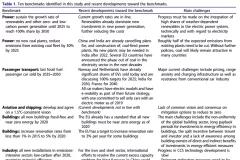This article identifies and quantifies the 10 most important benchmarks for climate action to be taken by 2020 – 2025 to keep the window open for a 1.5°C-consistent GHG emission pathway.
Abstract
We conducted a comprehensive review of existing emissions scenarios, scanned all sectors and the respective necessary transitions, and distilled the most important short-term benchmarks for action in line with the long-term perspective of the required global low-carbon transition. Owing to the limited carbon budget, combined with the inertia of existing systems, global energy economic models find only limited pathways to stay on track for a 1.5°C world consistent with the long-term temperature goal of the Paris Agreement.
The identified benchmarks include:
-
Sustain the current growth rate of renewables and other zero and low-carbon power generation until 2025 to reach 100% share by 2050;
-
No new coal power plants, reduce emissions from existing coal fleet by 30% by 2025;
-
Last fossil fuel passenger car sold by 2035–2050;
-
Develop and agree on a 1.5°C-consistent vision for aviation and shipping;
-
All new buildings fossil-free and near-zero energy by 2020;
-
Increase building renovation rates from less than 1% in 2015 to 5% by 2020;
-
All new installations in emissions-intensive sectors low-carbon after 2020, maximize material efficiency;
-
Reduce emissions from forestry and other land use to 95% below 2010 levels by 2030, stop net deforestation by 2025;
-
Keep agriculture emissions at or below current levels, establish and disseminate regional best practice, ramp up research;
-
Accelerate research and planning for negative emission technology deployment.
Key policy insights
-
These benchmarks can be used when designing policy options that are 1.5°C, Paris Agreement consistent.
-
They require technology diffusion and sector transformations at a large scale and high speed, in many cases immediate introduction of zero-carbon technologies, not marginal efficiency improvements.
-
For most benchmarks we show that there are signs that the identified needed transitions are possible: in some specific cases it is already happening.




